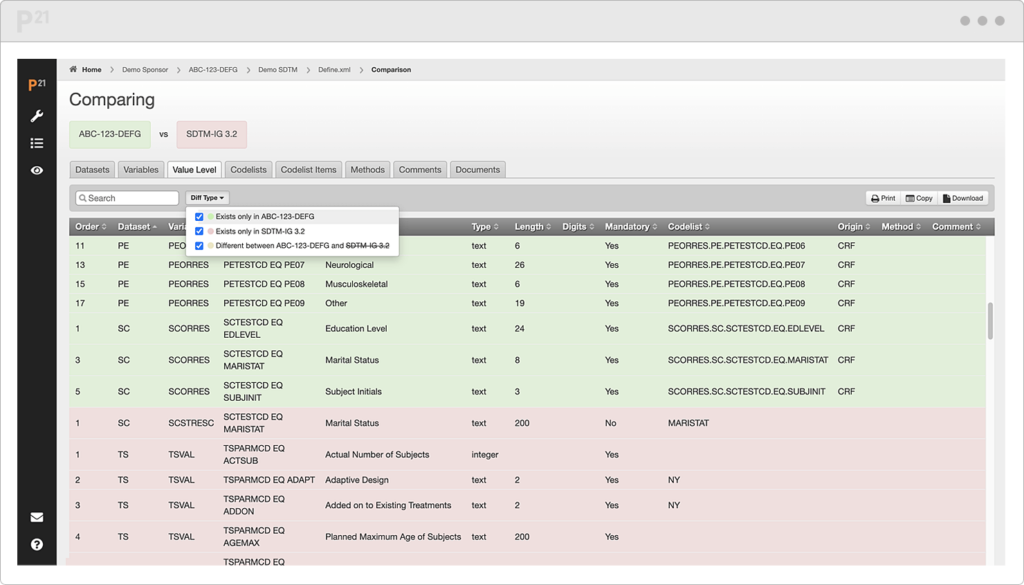Technology is designed to help us live and work smarter. That is exactly what P21’s Community and Enterprise applications were designed to do – to help study teams collect, transform, analyze, and submit clean, conformant clinical trial data for regulatory review and approval. However, there are major differences between the two platforms that extend well beyond desktop vs. cloud-based or open-source vs. subscription.
Whether you’re using open-source P21 Community, cloud-based Enterprise, or still relying on spreadsheets or other internal tools, understanding the differences between the applications will help you decide which solution is best for your team and answer the ultimate question: when is it time to level up to P21 Enterprise?
Below, we answer P21 Community users’ common questions and highlight some of the major differences between P21 Community and P21 Enterprise.
Q: “The P21 Community clinical trial data validation tool helps me find issues and correct them before submission. But I hate that I have to keep track of all the different configurations to set up the validations, like what versions of the standards and Controlled Terminology (CT) to use. I wish there was something built in to keep all that information handy for me.”
Whenever a user validates or creates a define/ specification in P21 Community, the configuration must be set up in the application each time. Unfortunately, other than maintaining and sharing an additional spreadsheet to try to track the configurations used for each validation of each data package, there’s no real workaround for this in P21 Community.
In P21 Enterprise, users can create a hierarchy of objects for studies and data packages that are used to house the validation or define. For each data package, the standard and dictionary versions only need to be set up once; thereafter, every time a validation is run in that data package, the same configuration settings are applied. There’s no need to search outside applications for out-of-date spreadsheets to ensure a validation is running with the right configuration.
Q: “P21 Community is great for spitting out a validation report, but when you validate repeatedly for the same study, it is hard to keep track of all the research that has been done for every issue and the explanations that have been decided upon. Transferring comments between reports can be time consuming. Is there a better way?”
P21 Enterprise stores comments and explanations added to issues, so there’s no need to copy, paste, or otherwise transfer comments to the latest validation report. This replaces the need to create external log files and emails outside the validation tool to manage issues. Issue management within P21E allows teams to collaborate, assign, and manage issues all in one place, and each issue has its own activity tab showing any changes made.
P21E’s validation history feature allows teams to view, compare, and export any validation runs for a given data package. Details about each validation, such as when a validation was run, whether a define was included, and number of records, are found within each data package’s validation history.
Q: “I just started programming CDISC datasets, and the first P21 report I got was gigantic. There were so many issues, and I had no idea where to start!”
It can be daunting to look at the huge validation report for the first time and think: “where do I begin?” In P21 Community, when using the FDA engine, values will only appear in the Severity column for reject issues. We recommend you start with those – they are highlighted in bright red and easy to spot. For all other issues, there is no value for severity because, unlike the PMDA, the FDA no longer publishes severity for every validation rule. When running a validation with the PMDA engine, severity values populate for every rule in P21C, but these are specific to PMDA’s needs.
In P21 Enterprise, FDA validation rules are assigned an ‘impact’ instead of a severity. When validations are run using the P21 or FDA engine, an impact value will display for each rule that fires; reject, high, medium, or low. These impact values are assigned by P21 SMEs and indicate how detrimental the issue can be once your data is under regulatory review. Impact values are an effective way to prioritize issues.
Q: “It’s great that P21 Community has a few different ways of creating a define file, but I’ve heard that P21 Enterprise has a ton of features that make it easy even for non-programmers to be able to help with this complicated document.”
The rumors are true; P21 Enterprise makes define easy. Its user-friendly design allows users to create a define in multiple ways:
- Create from study metadata
- Copy from a standard or from another study
- Import an Excel spec or define.xml file
- Use a blank template
Creating a define from study metadata populates approximately 80% of the define. Then, users view and edit the define in an intuitive grid-like UI in P21E. Define validation runs automatically, and any cells that need attention are highlighted. P21E even provides a description of changes or additions needed.
Multiple people across multiple teams can work on the define within P21 Enterprise and versions are saved in the system, allowing teams to revert to a previous version if needed. Users can compare the current version to a legacy or draft version, another study’s define file, or a standard, as well as preview the define.xml along with the style sheet right in the browser.

Q: “What about the Reviewer’s Guide? That takes forever to fill out.”
P21 Enterprise has an automated Reviewer’s Guide, so many sections are populated as it is generated based on the study and data package configurations set, as well as the metadata generated from the validated datasets. Consistency is maintained throughout submission documents, including all standards, CT, and dictionary versions. Those are pulled directly from the study, then the validation metadata is used to populate things like the trial design datasets table, datasets that contain screen failure information, SDTM domains, and analysis datasets.
When creating a cSDRG, supplemental qualifier tables are also populated within each domain subsection. Along with all these table populations, the complete list of issues – with the explanations entered in P21E – is automatically populated in your Reviewer’s Guide. This has proven to be a major time and resource saver.
Q: “I’m a staff programming director and there are easily over 70 studies led by my direct reports. Right now, I basically use the number of issues in the reports for each study to track the progress of the study and keep the team accountable, but it’s a pain doing this manually.”
P21 Enterprise gives you real-time oversight across studies, projects, or your entire portfolio. The analytics module offers a growing suite of reports to users to track KPIs and identify trends across trials. Users can see:
- Projected scores
- Frequency of validations per study or project
- Top firing issues across the portfolio
- Number of reject issues
- Which versions of which standards are in use
- How many data packages are using each standard and version
Study managers and supervisors may also view their team’s most active members and their quality of work to help identify super users. In the clinical trial space, metrics are important in driving decisions, and having a straightforward way to look at some of these KPIs in P21E is invaluable.

Q: “I tried creating a define spec for the first time the other day and I have no idea what all these columns are for. I did try checking the Community forum, but can’t just anyone post comments in there? Where’s the number for IT – I need help!”
There’s no dedicated support team to help with any issues with the open-source application, so the best place to look for answers to questions is Community’s forum. But it is true that anyone with a login can access the forum and post responses there, so look for the orange P21 tag next to a response’s date; this indicates that the response was authored by a Pinnacle 21 representative.
Because P21E is subscription-based, its customers have access to a wide range of materials specially created to educate users on industry trends and best practices, as well as help users navigate and perform tasks in P21E with maximum efficiency. Training materials include self-paced lessons, video tours, and quizzes.
Within P21E’s help center, users can find articles on upcoming features, new P21E releases, step-by-step instructions, and video demos. P21E clients also have access to dedicated Customer Success Managers, CDISC Subject Matter Experts, and top-notch Service Desk Specialists for technical and user support.
Q: “As a small organization, how do we know when it’s the right time to make the move from P21 Community clinical trial data validation tool to P21 Enterprise?”
There are two main factors to consider when deciding about the right time to upgrade:
- Pipeline maturity and pipeline volume. P21E works out-of-the-box for nonclinical studies, including validation of SEND datasets, scoring, guidance, and the creation of define.xml, and nSDRG. So potential users could choose to upgrade even if their studies are at this point. However, it may be worth waiting until it reaches the first clinical phase to upgrade because at that point, the stakes are higher, etc. Usually, we recommend that an organization with a therapy that is still in the SEND or preclinical phase of its lifecycle wait to upgrade. As soon as it passes into the clinical phase, the first phase looks to be going well, and the stakes are higher, that is usually a trigger to consider upgrading.
According to P21 Customer Success and Product Management professionals, many Community-turned-Enterprise users say, “I wish I had done this earlier.” That is because when the pipeline starts maturing and submission looks imminent, it is usually not the time when you want to do a technology upgrade.
- Pipeline volume: When an organization has three to five clinical trials ongoing, that is a good point to consider moving to the P21E cloud-based platform.
Sometimes, organizations think “I need to have hundreds of clinical trials before a scalable platform makes sense.” We advise the opposite. The smaller scale an organization’s operation is, the more they can benefit from our scale. Smaller teams receive the exact same scaled software platform used by the top 20 pharma companies, the top 12 CROs, and hundreds of larger companies in the industry – along with the same computing power.
With Pinnacle 21’s purpose-built tools, teams of all sizes have access to the most recent validation engines used by major regulatory agencies worldwide. But with P21E, organizations not only have access to expanded feature offerings, but to a team of professionals with experience dealing with hundreds of submissions. P21E’s subject matter experts, submission consultants, and data standardization experts are standing by to help.
Interested in talking with us about whether it is time to level up your study? Book a demo to see the platform in action.



